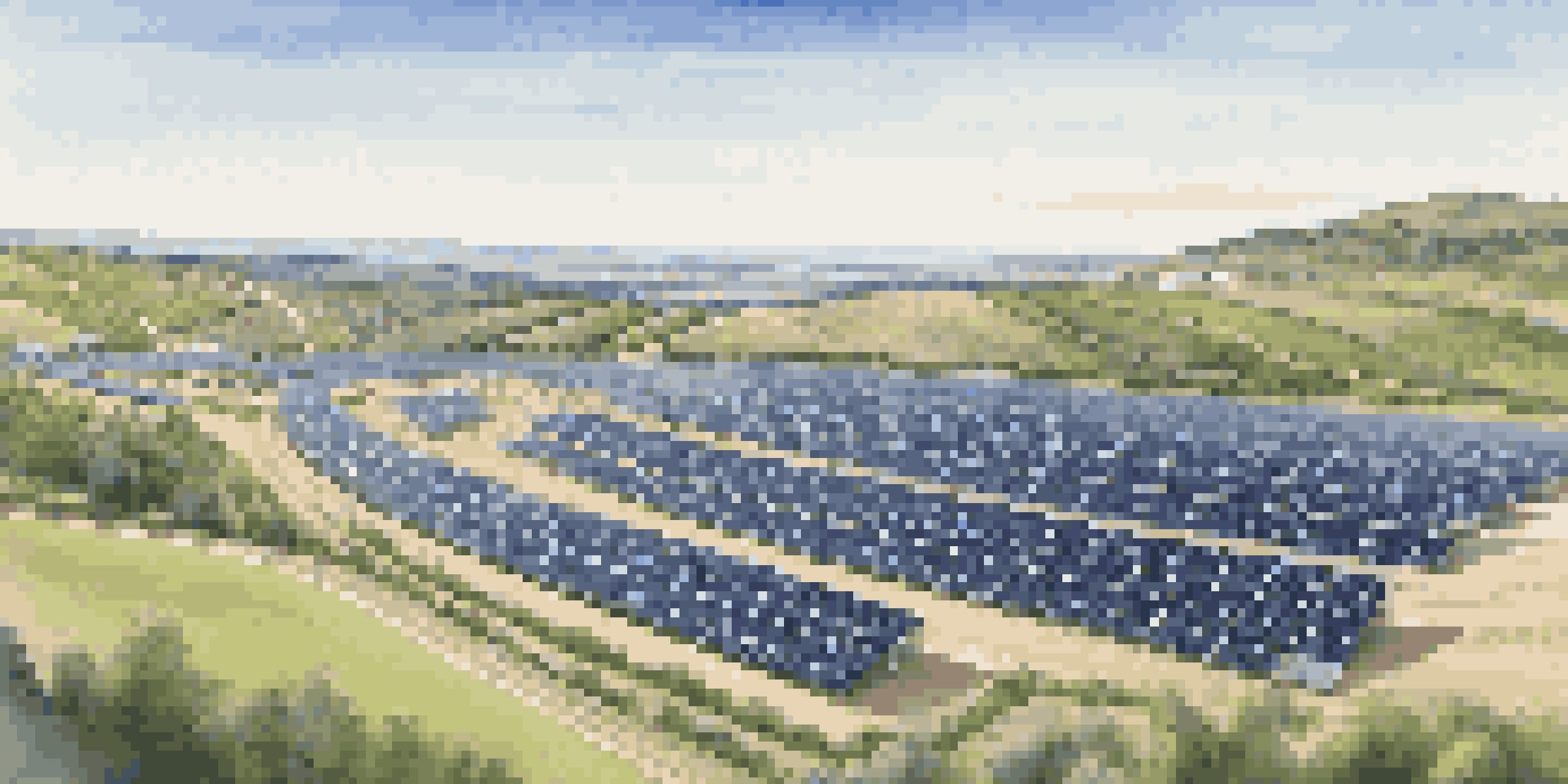The Economic Benefits of Investing in Energy Infrastructure

Understanding Energy Infrastructure and Its Importance
Energy infrastructure refers to the facilities and systems that produce, transmit, and distribute energy. This includes power plants, transmission lines, and renewable energy sources like solar and wind farms. Understanding this concept is key to grasping how investments in these areas can positively impact the economy.
The energy infrastructure is the backbone of a thriving economy, and investments in this area not only create jobs but also foster a sustainable future.
As populations grow and energy demands rise, the need for robust energy infrastructure becomes critical. Investing in this sector not only ensures a reliable energy supply but also supports job creation and technological advancements. In essence, a strong energy backbone is vital for any thriving economy.
Moreover, energy infrastructure is not just about meeting current demands; it’s also about future-proofing our energy systems. By investing in innovative technologies and sustainable practices, we position ourselves to address climate change while enhancing economic resilience.
Job Creation Through Energy Infrastructure Investments
One of the most immediate economic benefits of investing in energy infrastructure is the creation of jobs. Construction, maintenance, and operation of energy facilities require a diverse workforce, leading to thousands of new job opportunities. These positions often provide competitive wages and benefits, boosting local economies.

Additionally, the growth of renewable energy sectors, such as solar and wind, has sparked new job markets focused on green technology. As more individuals enter these fields, we see a shift towards sustainable employment practices, which can have long-term benefits for the economy and the environment alike.
Energy Infrastructure Fuels Growth
Investing in energy infrastructure generates job creation and economic stability, benefiting local communities.
Furthermore, job creation in energy infrastructure often has a ripple effect. As workers earn wages, they spend money on local services, stimulating further economic activity. This interconnectedness illustrates how energy investments can bolster entire communities.
Enhancing Energy Security and Economic Stability
Investing in energy infrastructure enhances energy security, reducing a nation's dependence on foreign energy sources. A stable energy supply means less vulnerability to market fluctuations and geopolitical tensions, which can destabilize economies. By developing local energy resources, countries can foster greater self-sufficiency.
Investing in renewable energy is not just an environmental imperative; it is an economic opportunity that can create jobs and drive innovation.
Moreover, a reliable energy supply supports various sectors, from manufacturing to healthcare. Businesses thrive when they have consistent access to energy, leading to increased productivity and economic growth. This stability can attract further investments, creating a virtuous cycle of growth.
In times of crisis, such as natural disasters or pandemics, strong energy infrastructure ensures that essential services remain operational. This resilience protects economic stability and reassures citizens, demonstrating the critical role that energy systems play in overall economic health.
Attracting Investment and Economic Growth
Robust energy infrastructure attracts both domestic and foreign investments. Investors seek environments where energy supply is reliable and efficient, as this directly impacts their operational costs. When a region is known for having strong energy systems, it becomes more appealing for businesses looking to expand or relocate.
Moreover, as governments prioritize energy infrastructure, they often offer incentives such as tax breaks or grants, further enticing investment. These financial incentives not only support infrastructure projects but also encourage companies to invest in local communities, fostering economic development.
Sustainability Drives Economic Benefits
Transitioning to renewable energy sources not only reduces carbon footprints but also leads to long-term economic advantages.
As businesses flourish due to improved energy infrastructure, they contribute to economic growth through increased employment, innovation, and consumer spending. This creates a thriving ecosystem where both energy and economic vitality can prosper.
Promoting Sustainable Economic Practices
Investing in energy infrastructure can lead to more sustainable economic practices. By prioritizing renewable energy sources, economies can reduce their carbon footprint and transition away from fossil fuels. This shift not only benefits the environment but also aligns with the growing consumer demand for sustainable practices.
Sustainability in energy infrastructure also translates to long-term economic benefits. Renewable energy technologies often have lower operating costs compared to traditional energy sources, which can free up resources for other economic investments. This efficiency fosters a more sustainable economic model overall.
Additionally, as countries lead in sustainable practices, they position themselves as innovators on the global stage. This leadership can attract international partnerships and funding, further boosting economic development and reinforcing the importance of sustainability in economic planning.
Boosting Local Economies Through Energy Projects
Energy infrastructure projects often have significant local economic impacts. When new energy facilities are built, they require local materials, services, and labor, which directly benefits local businesses. This can lead to a multiplier effect, where one investment leads to multiple economic benefits throughout the community.
Furthermore, energy projects can enhance local infrastructure, such as roads and utilities, which benefits residents and businesses alike. Improved infrastructure can increase property values and attract new residents, leading to further economic growth. This interconnectedness highlights the importance of energy investments in local development.
Public-Private Partnerships Enhance Impact
Collaboration between public and private sectors can mobilize resources and drive innovative energy projects for economic development.
As communities become more energy efficient and reliable, they become more attractive for new businesses and residents. This growth can create a positive feedback loop that fuels further investment and economic vitality, showing how local economies thrive with strategic energy infrastructure development.
The Role of Public-Private Partnerships in Energy Investment
Public-private partnerships (PPPs) play a crucial role in advancing energy infrastructure investments. By combining public resources with private sector expertise, these partnerships can mobilize financing and innovative solutions for energy projects. This collaboration can lead to more efficient use of resources and accelerated project timelines.
PPPs also allow for risk-sharing, which can make large-scale projects more feasible. When the public sector partners with private investors, the financial burden is lessened, encouraging more ambitious projects that can lead to significant economic benefits. This shared responsibility can lead to improved project outcomes and community support.

Moreover, successful PPPs can serve as models for future collaborations. As stakeholders witness the benefits of these partnerships, they may be more inclined to pursue similar arrangements in other sectors, ultimately fostering a culture of collaboration that enhances economic development.
Conclusion: The Economic Imperative of Energy Infrastructure Investment
Investing in energy infrastructure is not just a matter of keeping the lights on; it’s a critical economic strategy. From job creation to attracting investment, the benefits ripple throughout the economy, enhancing stability and sustainability. As we look to the future, prioritizing energy infrastructure will be essential for long-term economic health.
In a rapidly changing world, energy infrastructure investments can also drive innovation and resilience. By embracing new technologies and sustainable practices, we can create a more adaptable economy that meets the challenges of tomorrow. This proactive approach not only secures energy supply but also protects and enhances our economic future.
Ultimately, the economic benefits of investing in energy infrastructure are clear. As businesses, governments, and communities come together to prioritize this investment, we can build a stronger, more sustainable economic foundation that benefits everyone.